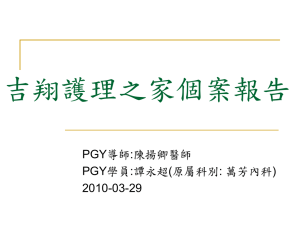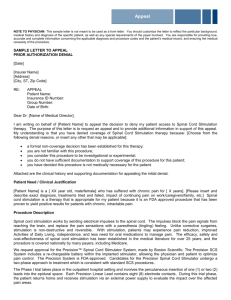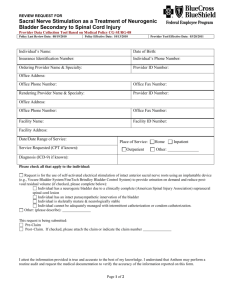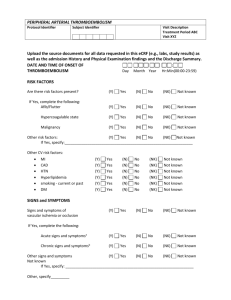Peripheral Vascular Disease and Chronic Critical Limb Ischemia
advertisement
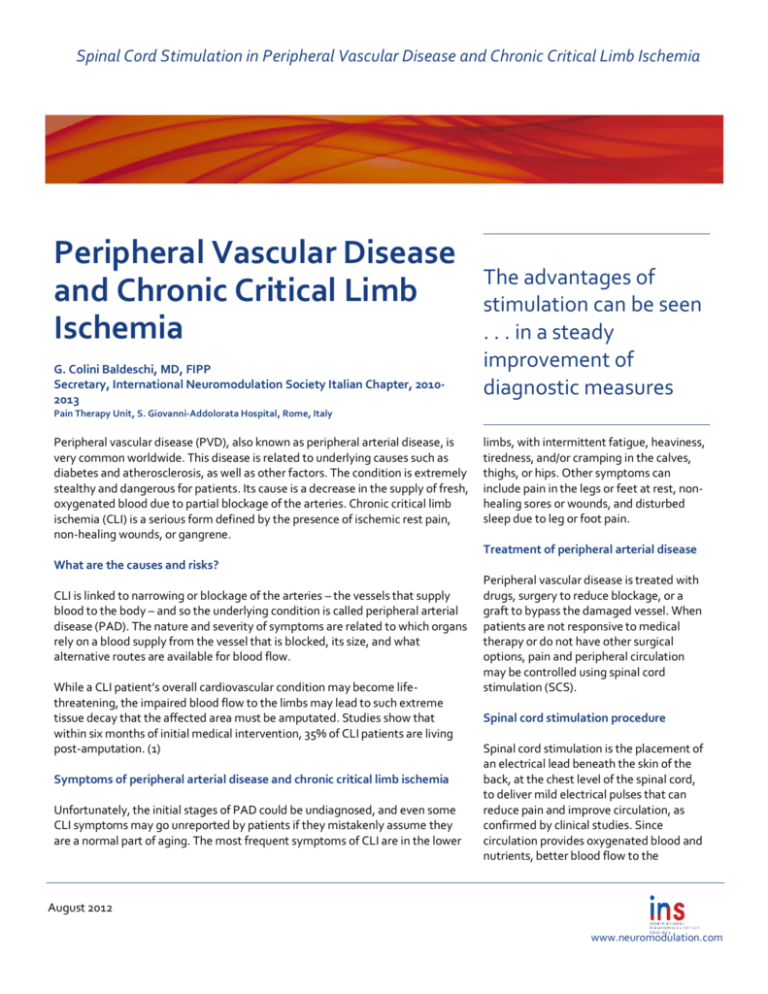
Spinal Cord Stimulation in Peripheral Vascular Disease and Chronic Critical Limb Ischemia Peripheral Vascular Disease and Chronic Critical Limb Ischemia G. Colini Baldeschi, MD, FIPP Secretary, International Neuromodulation Society Italian Chapter, 20102013 The advantages of stimulation can be seen . . . in a steady improvement of diagnostic measures Pain Therapy Unit, S. Giovanni-Addolorata Hospital, Rome, Italy , South West Deanery, U.K. Peripheral vascular disease (PVD), also known as peripheral arterial disease, is very common worldwide. This disease is related to underlying causes such as diabetes and atherosclerosis, as well as other factors. The condition is extremely stealthy and dangerous for patients. Its cause is a decrease in the supply of fresh, oxygenated blood due to partial blockage of the arteries. Chronic critical limb ischemia (CLI) is a serious form defined by the presence of ischemic rest pain, non-healing wounds, or gangrene. limbs, with intermittent fatigue, heaviness, tiredness, and/or cramping in the calves, thighs, or hips. Other symptoms can include pain in the legs or feet at rest, nonhealing sores or wounds, and disturbed sleep due to leg or foot pain. Treatment of peripheral arterial disease What are the causes and risks? CLI is linked to narrowing or blockage of the arteries – the vessels that supply blood to the body – and so the underlying condition is called peripheral arterial disease (PAD). The nature and severity of symptoms are related to which organs rely on a blood supply from the vessel that is blocked, its size, and what alternative routes are available for blood flow. While a CLI patient’s overall cardiovascular condition may become lifethreatening, the impaired blood flow to the limbs may lead to such extreme tissue decay that the affected area must be amputated. Studies show that within six months of initial medical intervention, 35% of CLI patients are living post-amputation. (1) Symptoms of peripheral arterial disease and chronic critical limb ischemia Unfortunately, the initial stages of PAD could be undiagnosed, and even some CLI symptoms may go unreported by patients if they mistakenly assume they are a normal part of aging. The most frequent symptoms of CLI are in the lower Peripheral vascular disease is treated with drugs, surgery to reduce blockage, or a graft to bypass the damaged vessel. When patients are not responsive to medical therapy or do not have other surgical options, pain and peripheral circulation may be controlled using spinal cord stimulation (SCS). Spinal cord stimulation procedure Spinal cord stimulation is the placement of an electrical lead beneath the skin of the back, at the chest level of the spinal cord, to deliver mild electrical pulses that can reduce pain and improve circulation, as confirmed by clinical studies. Since circulation provides oxygenated blood and nutrients, better blood flow to the August 2012 www.neuromodulation.com Spinal Cord Stimulation in Peripheral Vascular Disease and Chronic Critical Limb Ischemia extremities encourages wound healing and tissue health. Patients whose pain is reduced may also be more likely to move about, which helps to reduce unhealthy swelling and aids circulation. An SCS system is implanted in two phases, which are performed in the operating room under local anesthesia with mild sedation. The first phase allows the patient to undergo a trial period of about 15 days. It begins with a procedure that uses a hollow needle to create a small puncture, without an incision, through the skin of the back to allow the clinician to insert a temporary lead. The end of the lead has electrodes about the size of a grain of rice that are positioned on the spinal cord. Once the electrodebearing lead has been positioned, test stimulation is performed while the patient reports when he or she feels a pleasant electric current that covers most of the painful area (at least 80% of it). The second phase is a permanent implant if a patient has had at least 50% pain reduction and/or improvement of other instrumental screening that indicates improvement in circulation to the capillaries. In this phase, a totally implantable pulse generator is positioned in a pocket of the abdomen or buttock. Potential positive outcomes The advantages of stimulation can be seen in a decrease in symptoms (less limb fatigue and cramping, more wound healing, a significant reduction of pain and swelling, the ability to sleep lying down without pain, and an improvement of quality of life), and also in a steady improvement of diagnostic measurements indicating blood flow to the extremities. Finally, in cases in which the disease has led to some irreversible tissue damage, the extent of amputation may be reduced as a result of improved microcirculation. After individualized parameters are programmed, each patient is given a remote control to be able to adjust the intensity of stimulation at home. Footnote 1. Dormandy JA, Rutherford RB. Management of peripheral arterial disease (PAD). TASC Working Group. TransAtlantic Inter-Society Consensus (TASC). J Vasc Surg. 2000; 31(1 pt 2):S1–S296. Resources NHLBI Diseases and Conditions Index: Peripheral Arterial Disease (P.A.D.) http://www.nhlbi.nih.gov/health/healthtopics/topics/pad/ Vascular Disease Foundation 550 M Ritchie Highway PMB-281 Severna Park, MD 21146 +1 410-421-8049 http://vasculardisease.org/padcoalition/ Centers for Disease Control and Prevention, National Center for Chronic Disease Prevention and Health Promotion, Division for Heart Disease and Stroke Prevention 4770 Buford Hwy, NE Mail Stop F-72 Atlanta, GA 30341-3717 800-CDC-INFO TTY: 800-232-6348 http://www.cdc.gov/DHDSP/data_statistics/f act_sheets/fs_PAD.htm Please note: This information should not be used as a substitute for medical treatment and advice. Always consult a medical professional about any healthrelated questions or concerns. References 1. Amann W, Berg P, Gersbach PA et al. Spinal cord stimulation in the treatment of non-reconstructable stable critical leg ischaemia: results of the European peripheral vascular disease outcome study (SCS-EPOS). Eur J Vasc Endovasc Surg 2003; 26:280-286. 2. Spincemaille GH, de Vet HC, Ubbink DT et al. The results of spinal cord stimulation in critical limb ischaemia: a review. Eur J Vasc Endovasc Surg 2001; 21:99-105. 3. Colini Baldeschi G., Carlizza A. 2011. Spinal Cord Stimulation: Predictive Parameters of Outcome in Patients Suffering from Critical Lower Limbs Ischemia. A Preliminary Study. Neuromodulation 2011; 14: 530–533. Copyright 2012 2 C-PVD.8.12



